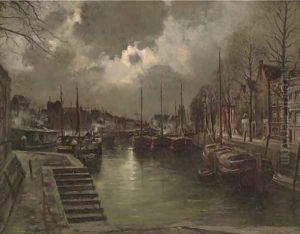Pierre-Franc Lamy Paintings
Pierre-François Eugène Giraud, known as Pierre-Franc Lamy, was a French artist born on November 7, 1855, in Mâcon, France. Despite his relatively obscure status today, Lamy was an active and respected artist in his time. He specialized in genre painting, portraiture, and decorative arts, often employing a style that was influenced by the academic and classical traditions prevalent during the 19th century. Lamy's artistic journey led him to study at the Ecole des Beaux-Arts in Paris, which was the foremost art institution in France, emphasizing traditional techniques and grand historical themes.
Throughout his career, Lamy exhibited his works at the Paris Salon, an official art exhibition of the Académie des Beaux-Arts in Paris. The Salon was the most important annual and biannual art event in the Western world at the time. By exhibiting there, Lamy would have been part of the mainstream art scene, gaining exposure and the opportunity to sell his works to a wider audience, including patrons and collectors. Lamy's paintings often reflected the tastes of the bourgeois and aristocratic patrons of the time, which favored well-executed portraiture and historical scenes.
His works were recognized for their technical skill, composition, and ability to capture the essence of his subjects. However, as the century turned and the art world moved towards Modernism, with artists like Pablo Picasso and Henri Matisse breaking new ground, the traditionalist approach of painters like Lamy became less fashionable. As a result, many academically trained artists of the 19th century fell out of favor with the avant-garde art community and subsequently with the broader historical narrative of art.
Pierre-Franc Lamy's death on December 28, 1919, in Neuilly-sur-Seine, marked the end of his life but also the passing of an era in art. The post-World War I period saw a dramatic transformation in the art world, with the decline of academic art and the rise of various avant-garde movements. Lamy's legacy, like that of many of his contemporaries, became somewhat overshadowed by the subsequent revolutions in artistic expression. Nevertheless, his contributions to the 19th-century French art scene remain a testament to the era's rich artistic traditions.
